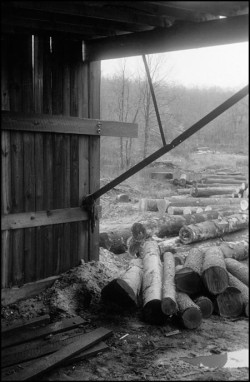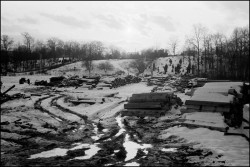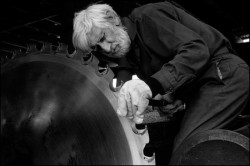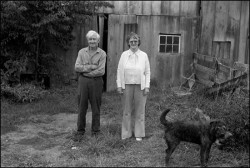I’ve been lucky enough to have met a lot of interesting people in my life. I’ve known some wonderful characters in the New York film business, and I’ve traveled the world to meet great people in other countries. Still, the most memorable person I’ve known lived here in Lyme, Connecticut: the woodsman Amos Congdon, who has meant far more to me than the expresidents and their wives, the athletes and coaches, or the movie stars I might have met.
He was born on the first day of spring in 1899. A small man, though he said he’d been “stout,” that is, strong, when he was young; able to lift an anvil into the truck bed when no one else could do it. He had bright blue eyes, snow-white hair, and most often a white beard as well. He wore the cotton shirt and pants uniform of the American working man: the Dickie brand, or sometimes Lee. On days he’d wear all blue, I’d see him as the spirit of the Union. When he wore gray, I’d see him as Confederate. This was in the early ‘70s, when the civil rights battles were being fought, war in Vietnam was raging. When he’d wear blue and gray, which he often did, I’d see him as the spirit of the country, united once again.
A small family-run hardwood mill – a tie mill they called it – for railroad ties, the main product they had starting up. The rectangular shed, 75 feet long and 35 feet wide, is open on three sides. Built on a north-south line with the saw to one side facing west. Two iron rails, 45 feet long, set on cement piers run in front of the saw blade. A carriage pulled by a cable carries the log down the tracks into the saw to make each cut. Reversing direction on the sawyer’s action, it returns to him so he can turn the log and set its next position. The bright aluminum roof has scattered patches of green fiberglass so the light underneath is often a faint green for our work. The front half of the mill has a floor of thick oak planks, dark and twisted over the years, raised high enough off the ground so trucks could be loaded off the front. The back is earthen, bark and wood scraps, lengths of poison ivy vine, broken tools, pieces of chain, plastic kitchen containers for oil and gas, and the oak skids where logs are piled waiting to be sawn. The saw is a bright silver disc after a day of work. It can rust and turn dark overnight.
He climbs up on the rollers with a file in his hand. Two oil rags are thin pads for his knees. He kneels at the saw, still for a second, resting on his heels, then he rises up and leans over the saw blade. Using the file as a bar, he pulls the first tooth to him. All the sawmill’s belts and wheels turn that one portion of the saw’s circle in a soft, quick moan. Holding the file in two hands, he sets it into the curve of the socket. Then he strokes it across the tooth face, once, twice, maybe three times. The sound is surprisingly soft. Amos taps the file on a small iron wheel at his side. It sounds like a bell. He taps it again to clear it of steel filings. And then he might say, “Years ago everything was pure, the rivers, the air, and the soil. Now it isn’t so.” He pulls the next tooth toward him and the mill’s actions turn again, the one small fraction of the saw’s rotation.
Maybe it takes five or six seconds to cut the length of the log, small red pine logs, “bony logs” or “pecker poles,” as they might say. Amos pulls the pine slab away from the saw, waits for the carriage to pass by him, stop at the end of the tracks, reverse direction and return to the sawyer. He lifts the pine with two hands and steps quickly across the tracks, throws the slab up on a pile and turns back toward the saw. Quickly crossing the tracks a step in front of the carriage, he stands at his place by the saw, reaches down to clear the bark and ice off the rollers. The saw blade is turning over 700 times a minute. It’s a hiss and a whir under the noise of the diesel. He’ll take away each piece of wood, and carry each board to its pile. Drop the 4-by-6, 6-by-6 lumber into the pits, hurry back to his place at the saw every time. “Carrying slabs” is what they called it; or “taking away,” “off-carrying.” There are 50, maybe 60 logs on the skids. It takes only a minute or two to saw out each log, this bony red pine. He has 8, maybe 10 seconds to carry each piece away and return to the saw. He’ll do it five, six times for each log. Three hundred times or more he’ll carry-away before they stop work. Sawing red pine, Amos Congdon, 76 years old.
I know construction of this sawmill in the early ‘70s was the proud accomplishment of a lifetime of hard work, by both himself and his wife, Bertha. His work in the woods, chopping brush with an ax for birch and witch hazel oils, sawing out logs for other men’s mills, hickory for firewood to New York City, cedar poles to net the tobacco around Hartford, mowing hay in the meadows with a scythe and salt hay in the marshes as well. Mrs. Congdon’s hard work in small factories across the river, in Westbrook and Essex, at a steam laundry in Old Saybrook. All three sons were sawyers. That seems a great accomplishment to me…to teach three sons to saw.
Let me tell you one last story about him. He and his wife had been living together in one room at a nursing home in Essex. He was taking care of her in his mind and she likewise was taking care of him. Mrs. Congdon passed away first. I went to offer my condolences. He was totally distraught. I knew there was really nothing I could do to comfort him. I sat down beside him. He was 92. Cartoons were on the TV in front of us. After a while, a nurse brought his lunch. She put the tray in front of him. “Come on, Amos, you have to eat something,” she said and then left the room. On one side of us was a black woman, a white and black polka-dot bandana on her head, faded man’s white shirt, a ragged blue cardigan sweater; angry, wild eyes, muttering, cursing to herself. On the other side, a middle-aged white man in a wheelchair, dressed in a Perry Como sweater like an insurance salesman from a generation before, a dull silver-blue tie, blue shirt, and gray summer flannels. Brain damaged, ugly, heavy, and silent in his chair. Amos and I sat for a while.
His lunch was cold tomato soup, a piece of bread with margarine, a gray pear, cup of ginger ale, black coffee. I encouraged him to eat. Finally he took the bread in his hands and broke it into pieces. He offered me a piece. Did I want it? He offered some to the empty white man and the muttering black woman as well. Will we share this bread with him? I remember thinking at the time, “What a great presence of mind he has.” Always, you know? A wonderful spirit, good and kind. How proud I was to be with him then. How glad, how thankful I am to have known him.

















